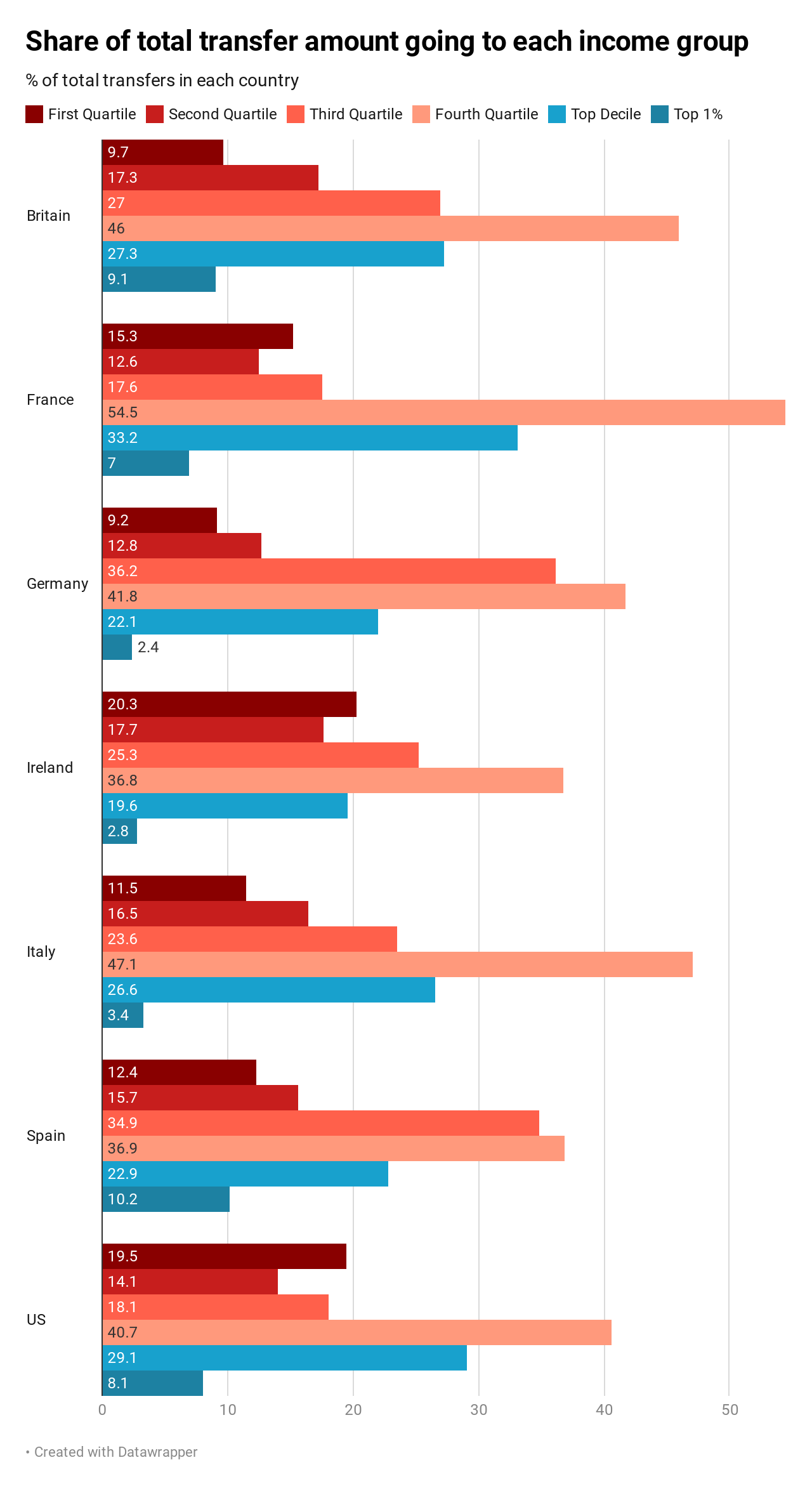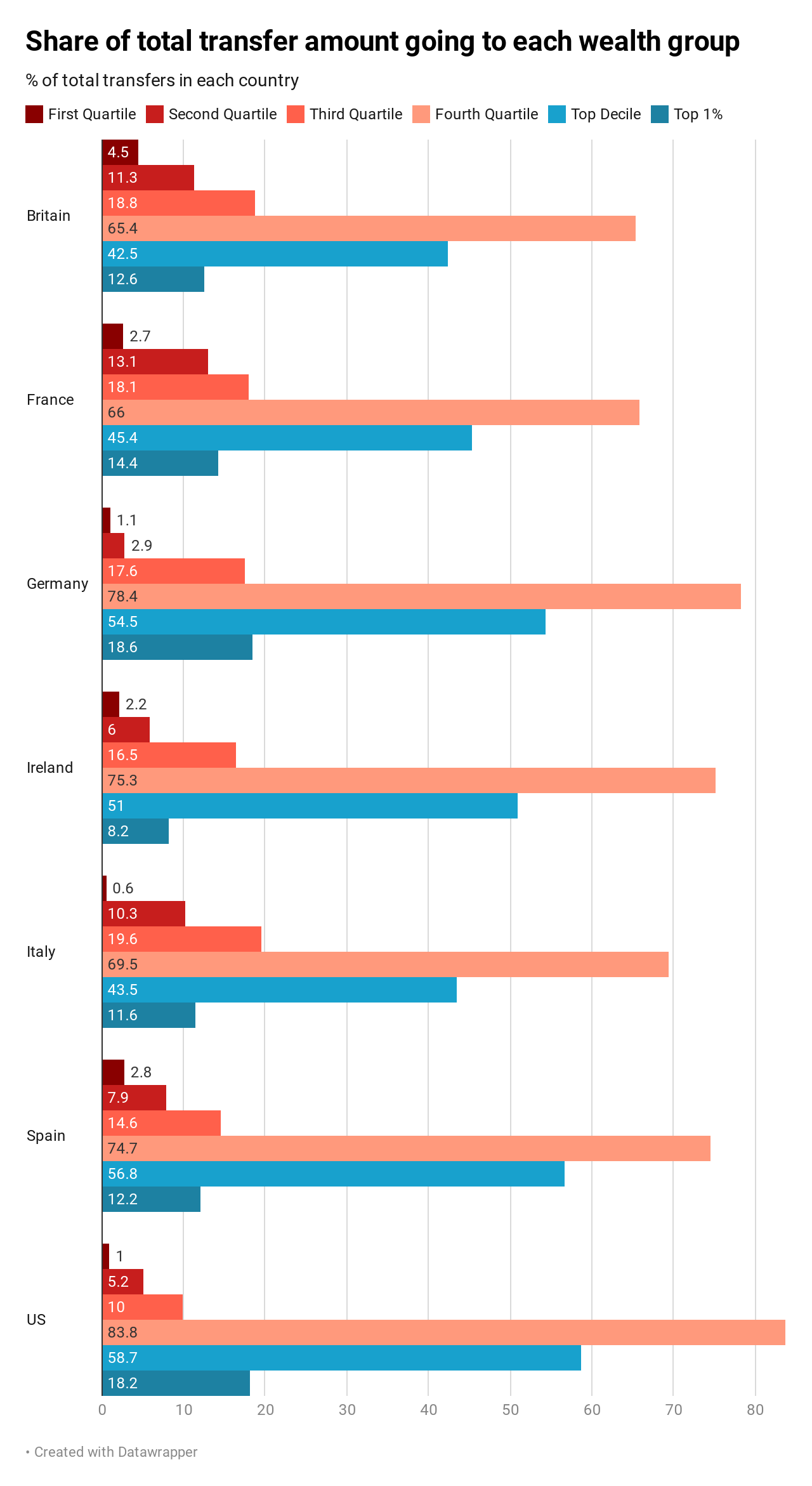The distribution of wealth is of major concern for its potential economic, social, and political impact. In particular, wealth transfers between generations give rise to a variety of normative and practical issues with respect to taxation that loom large in current debates.
These transfers are most often studied and debated in their different national contexts, but in a recent study we instead apply a comparative lens to household survey data on inheritance and gifts inter vivos in seven rich countries (Nolan et al. 2020). The data were collected between 2010 and 2014 in France, Germany, Great Britain, Ireland, Italy, Spain, and the US.
The surveys employed – the Wealth and Assets Survey for Britain, the Survey of Consumer Finances for the US, and the Euro-zone Household Finances and Consumption Survey for the other countries – are specially designed to capture details of current wealth levels and composition and include retrospective questions on inheritances and gifts received in the past. The data allow us to identify common patterns versus national idiosyncrasies in the extent and nature of intergenerational wealth transfers.
The data also allow us to relate current wealth levels of households and inequality between them to the receipt of these transfers in the past or its absence. This provides a comparative window on the critical question of how much intergenerational transfers contribute to wealth inequality, which continues to be hotly debated in the academic literature.
Key features of wealth transfers in rich countries
About one-third of households reported receiving an intergenerational wealth transfer at some point in the past across most of the countries we studied, but that figure was only 19% in the US. The average aggregate amount received was consistently much higher than the median, as very large receipts boosted the average. Most of the total value of transferred wealth was via inheritances rather than gifts in Britain, Ireland, Italy, Spain, and the US, whereas for France and Germany, about one-third of the total reported amount received was via gifts.
One would expect the receipt of inheritances and gifts to be strongly related to where individuals and their parents are in their life-cycles. We find some receipt to be quite common across the entire age distribution (except in the US, where few aged under 35 report any), but the average transfer receipts are consistently lowest for the youngest age group – typically, only about 5% of transfers has been received by them. Those aged 65 or more have had the longest time to accumulate transfers and received the largest share of the total in Britain, Italy, the US, and especially France, but the ‘middle-aged’ have done so in Germany and Spain (Figure 1).
Figure 1 Share of total transfer amount going to each age group
The proportion reporting receipt generally rises with income, but the variation is often not so strong, and a substantial number of households in the bottom quarter and half of the income distribution have benefitted from transfers. Mean amounts received generally also rise as one moves up the income distribution, so households in the top current income quartile generally received 40%–50% of total transfers compared with about 10%–15% for the bottom quartile (Figure 2).
Figure 2 Share of total transfer amount going to each income group
Ranking households by current wealth rather than income level, the likelihood of having received an inheritance or gift was seen to increase rather consistently with wealth rank across these countries. In five of the six countries, a substantial minority of those in the top 1% reported no inheritance or gift receipt, and in the US only 39% reported any such receipt.
The average amount received generally also rises as one moves up the wealth distribution and are by far the largest for recipients in the top 1%. Households in the top 1% received as much as 18% of the total amount transferred in in Germany and the US. By contrast, the share going to those in the bottom quarter of the current wealth distributed is generally very low indeed (Figure 3).
Figure 3 Share of total transfer amount going to each wealth group
Who receives intergenerational transfers?
We probed the characteristics of those who had versus had not received intergenerational transfers and the varying amounts they received via regression, employing both two-stage and Poisson models. The estimation results show that in addition to age, the level of education was a strong predictor everywhere, with the relative advantage of those with tertiary education being particularly marked in Britain and the US.
In Britain, for example, someone with a third-level qualification was 28% more likely to have received some intergenerational transfer than someone with only lower secondary education, controlling for age and gender and, among recipients, would be expected to have received 68% more on average.
The expected level of intergenerational transfers is low across the first tranche of the income distribution in most countries, then ‘takes off’ after about the 20th percentile; for the US this slope is particularly flat around the middle of the distribution, with a strong association with income at the tails.
Intergenerational transfers and household wealth
The influence of having received intergenerational transfers on the household’s current level of wealth is critically important but very difficult to assess reliably. The average wealth of transfer recipients is much higher than that of non-recipients in all countries, with that gap being particularly wide in the US. The relationship between transfer receipt and owning one’s own house accounted for a substantial proportion of the difference, but financial and business wealth also played a major role in Britain and even more so in the US. When we control statistically for differences in age, education, and household size, the wealth gap between recipients and non-recipients narrows but remains substantial.
When we confine the analysis to those aged 50 or over, to limit the role of age, receiving some intergenerational inheritance or substantial gift is associated with ranking about 20 percentiles higher in the wealth distribution than non-recipients, controlling for age and education. Incorporating the size of the transfer into this analysis revealed that while receipt of a transfer of any size is associated with a higher rank, that gap is considerably greater for the largest transfers.
Intergenerational transfers and household wealth inequality
We now turn to the even more tangled question of the influence of wealth transfers on overall wealth inequality. Some recent studies (such as Boserup et al. 2016 and Elinder et al. 2018) conclude that inheritance is equalising rather than dis-equalising, in effect because less-wealthy heirs inherit amounts that are greater relative to their pre-inheritance wealth than wealthier ones.
However, rather than (implicitly) comparing with a situation where there were no wealth transfers, it may be more relevant to ask what the wealth distribution would look like if transfers were distributed differently, or if there were more or fewer transfers. We therefore employ (re-centred) influence function regression methods, which capture how marginal changes in the distribution of covariates impact on distributive statistics, and calculate the effect that a marginal increase in the number of households in receipt of transfers would have on the overall shape of the wealth distribution, holding constant the wealth distributions conditional on the transfer.
The results suggest that, in most of the countries studied, having more transfer recipients and correspondingly fewer non-recipients, or more recipients of small or medium-sized transfers, would reduce wealth inequality modestly. This reflects the fact that those transfer recipients were more concentrated around the middle of the wealth distribution than non-recipients. In contrast, increasing the proportion of recipients of large transfers generally increased overall wealth inequality.
These findings reinforce the notion that the overall effect of intergenerational wealth transfers may be equalising but highlights a crucial heterogeneity in impact, depending on the size of the transfers, that has not been recognised in the previous literature. This analysis is descriptive and static; it does not attempt to identify causal or general equilibrium impacts but is nonetheless informative.
Taxing intergenerational wealth transfers
The policy implications, most obviously for taxation of wealth transfers, are significant. The dis-equalising impact of large transfers – in terms of overall wealth inequality – reinforces the notion that strengthening the capacity to effectively tax such transfers has to be a key element in reforming capital transfer taxes.
The wealth transfer tax systems in operation in the countries we studied vary widely, including whether taxes are levied on the estate of the deceased or the beneficiaries, how bequests versus gifts are treated, and how thresholds, allowances, and exemptions function, over and above the more easily compared headline marginal rates of tax.
It is difficult to detect the clear effects of the differences in tax systems on the patterns of intergenerational transfers across countries given all the other differences among them. However, some studies have linked changes in transfer behaviour over time to changes in tax treatment.
The case for moving towards a lifetime capital acquisitions tax for gifts and inheritances can be convincingly made purely in terms of fairness and efficiency. While this also has the potential to reduce the role these transfers play in generating wealth inequality, its equalizing effect could be considerably enhanced if combined with direct wealth endowments to all young people along the lines proposed by Atkinson (2015), Milanovic (2019), and on the most ambitious scale by Piketty (2019).
Authors’ note: This research was supported by the Nuffield Foundation but the views expressed are those of the authors.
References
Atkinson, A B (2015), Inequality: What can be done? Cambridge MA: Harvard University Press.
Boserup, S, W Kopczuk and C Kreiner (2016), “Wealth inequality: Evidence from the role of bequests in shaping wealth inequality”, American Economic Review 106(5): 656–61.
Elinder, M, O Erixson and D Waldenström (2018), “Inheritance and wealth inequality: Evidence from population registers”, Journal of Public Economics 165: 17–30.
Milanovic, B (2019), Capitalism, alone. Cambridge MA: Harvard University Press.
Nolan, B, J C Palomino, P Van Kerm and S Morelli (2020), “The wealth of families: The intergenerational transmission of wealth in Britain in comparative perspective”, Nuffield Foundation and INET at the Oxford Martin School.
Piketty, T (2019), Capital and ideology, Cambridge MA: Harvard University Press.









